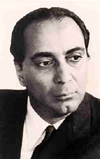| Homi Jehangir Bhabha (1909 - 1966) |
Son of a barrister, Homi Jehangir Bhabha was born in Bombay on October 30, 1909. He grew up in a totally aristocratic and rich environment. After passing the Senior Cambridge Examination at the age of sixteen, he joined the Gonvile and Caius College in Cambridge with an intention to pursue mechanical engineering. After obtaining his honors degree in 1930, he began to do research at the Cavendish Laboratories at Cambridge.
He received his Ph.D. in 1935 and remained in Cambridge until 1939. When the war broke out in Europe, Bhabha who was on his holiday in India decided to stay back.
|
 |
In 1940, C.V. Raman requested him to join the Indian Institute of Science, Bangalore. A theoretical physicist by training, Bhabha realized the relationship between theory and experiments, and started experiments in the area of Cosmic rays. He was elected fellow of the Indian Academy of Sciences, and in 1943, he was elected the President of the Physics section of the Indian Science Congress.
Bhabha approached JRD Tata for an institute, which would be fully devoted to fundamental research. JRD a visionary in his own rights was impressed and this laid a foundation and soon establishment of the Tata Institute of Fundamental Research (TIFR) in Bombay in 1945, with Bhabha as the Director, a position he held till his last day.
Bhabha gained international stature in the scientific community. He served as the President of the United Nations Conference on the Peaceful Uses of Atomic Energy, first held in Geneva in 1955, and from 1960-1963 as President of the International Union of Pure and Applied Physics. He died in a plane crash on Mount Blanc in 1966.
|
|
| |
| Category filed under: Scientist |
|
|